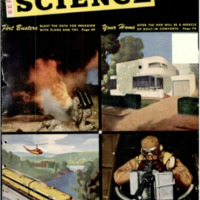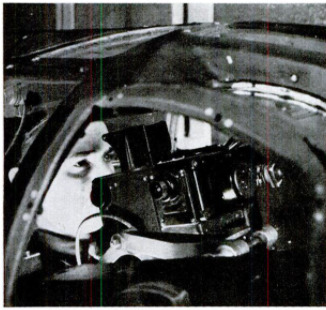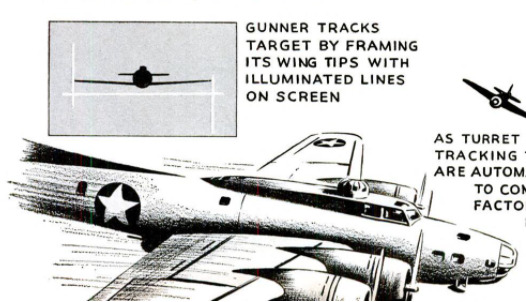Robot brain aims turret guns
Item
-
Title (Dublin Core)
-
Robot brain aims turret guns
-
Article Title and/or Image Caption (Dublin Core)
-
Title: Robot brain aim turret guns
-
Subtitle: Computing sight gives bombers deadly firepower
-
extracted text (Extract Text)
-
AMERICA'S Flying Fortresses and Lib-
erators have enjoyed their signal suc-
cess at daylight bombing over Europe and
in the Pacific because of their terrific fire
power, which enables them to fight their
way in and out against the best Axis fighter
opposition. Behind this deadly bomber de-
fense is a little black box which has, here-
tofore, been kept on the “secret” list. This
is the new Sperry Automatic Computing
Sight, a compact and simply operated me-
chanical brain that does most of the gun-
ner’s thinking for him.
Its use has resulted not only in greater
accuracy but in increased range. Twin .50
caliber guns fitted with the automatic sight
now have an effective range of more than
1,000 yards. Mounted centrally between the
guns, the sight swings or raises or lowers
as the guns are tracked. The gunner peers
into an optical sight, keeping the enemy
plane “framed” between two vertical lines.
He may alter the distance between these
lines by moving a pedal with his left foot,
and as long as these lines frame the hostile
ship, the guns are “on target.”
Upon attack, the gunner moves a small
knob on the right side of the little black box
to correspond with the known wing span
of the enemy plane. Recognizing the at-
tacker as a Messerschmitt 109G-2, for ex-
ample, the gunner sets the knob so that the
scale reads 33, the plane's approximate wing
span. As the plane approaches, the gunner
keeps it framed by moving the vertical lines
in his sight with the foot pedal.
Although he seems to be aiming directly
at the enemy ship, the guns are actually
pointed ahead of the plane, “leading” it as
in skeet or duck shooting. Allowance is
also made automatically for vertical ascent
or descent and the effect of the wind. Since
deflection and windage have been two of the
gunner’s biggest problems, the new sight
will speed training of new gunners.
SWIMMING WITH A PACK is
not as difficult as it sounds. Far
from weighing him down, a sol-
dier’s regulation 60-pound load
will actually provide enough
buoyancy to keep him afloat for
a time, When the equipment is
properly arranged, air is trapped
inside the bag and remains until
the fabric is thoroughly soaked.
The swimmer is so well sup-
ported that he can even aim and
fire his rifie while floating in
midstream. If he has no pack,
a fighting man can apply the
same principle by knotting a pil-
low slip or even a pair of pants
so that it will hold enough air
to take the place of water wings
or a flotation bladder. Such tac-
ties will be handy in landings
and other amphibious operations.
HOME, SWEET HOME
for glider mechanics at ad-
vanced invasion bases will
be the seven by 24-foot
weatherproofed crates in
which their gliders reach
them. Student mechanics
in training at Sheppard
Field, Tex., are taught how
to make themselves at
home in the boxcarlike
crates in preparation for
the day when they will use
them as huts. At the left,
trainees are seen moving
cots and bedding into one
of the crates, which they
christened “Glider Inn.”
-
Language (Dublin Core)
-
eng
-
Date Issued (Dublin Core)
-
1943-09
-
pages (Bibliographic Ontology)
-
71-72
-
Rights (Dublin Core)
-
Public Domain (Google Digitized)
-
Archived by (Dublin Core)
-
Matteo Ridolfi
-
Marco Bortolami (editor)
 Popular Science Monthly, v. 143, n. 3, 1943
Popular Science Monthly, v. 143, n. 3, 1943




